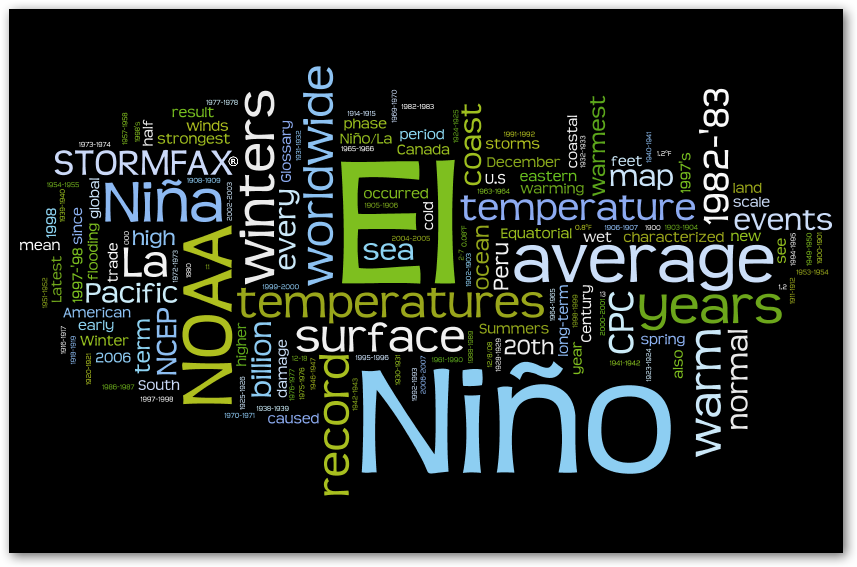


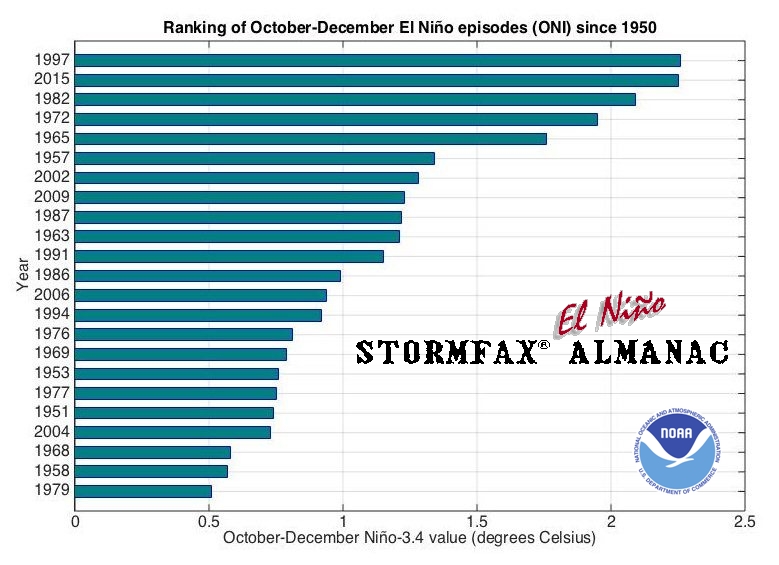
El Niño is characterized by a large scale weakening of the trade winds and warming of the surface layers in the Equatorial eastern and central Pacific Ocean. El Niño events occur irregularly at intervals of 2-7 years, although the average has been, until recently, about once every 3-4 years and lasting 12-18 months. (see Table)
El Niño events often result in flooding in California and parts of the midwestern United States, while the southern half of the US experiences cooler-than-normal winters. Winters are generally warmer than normal in the northern half of the US. During El Niño years, there are fewer hurricanes in the Atlantic.
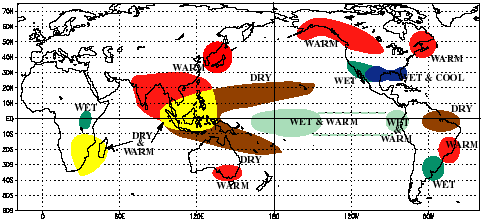
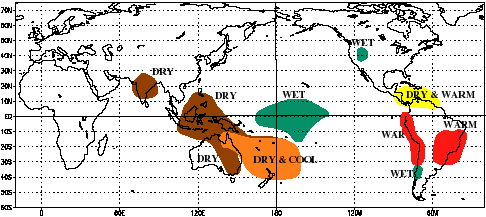
There has been a confusing range of use for the term "El Niño" by both the scientific community and the general public. Originally, the term El Niño (the young boy, in reference to the Christ child) denoted a warm southward-flowing ocean current that occurred every year around Christmas off the west coast of Peru and Ecuador. The term was later restricted to an unusually strong warming that disrupted local fish and bird populations every few years. However, as a result of the frequent association of South American coastal temperature anomalies with interannual basin-scale equatorial warm events, El Niño has also become synonymous with larger scale, climatically-significant, warm events.
Conversely, La Niña is the cold counterpart of El Niño where sea surface temperatures in the tropical Pacific fall below normal. This phase is characterized by warm winters in the southeastern United States, colder-than-normal winters from the Pacific Northwest to the Great Lakes, and unsettled winters in the Northeast and Mid-Atlantic states.
The original name given to this Cold Phase was "El Viejo" meaning the old man.
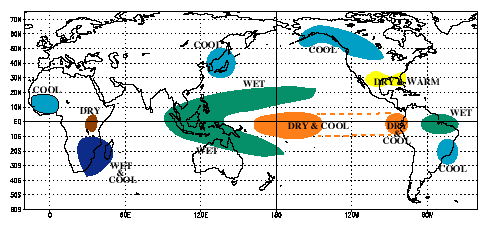
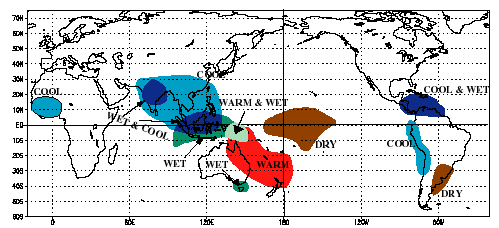
Until the 1997-'98 El Niño, the 1982-'83 episode had been the strongest and most devastating of the 20th Century. During that period, the trade winds not only collapsed--they reversed.
It caused weather-related disasters on nearly every continent. Australia, Africa and Indonesia suffered droughts, dust storms and brush fires. Peru received the heaviest rainfall on record: 11 feet in areas where 6 inches was normal.
The 1982-'83 El Niño was blamed for as many as 2,000 deaths and more than $13 billion in damage to property and livelihoods worldwide. During this period, the thermocline off the South American coast dropped to about 500 feet. On September 22, in just 24 hours, sea-surface temperatures along the coastal village of Paita, Peru rose 7ºF.
There were also secondary problems caused by the 1982-'83 El Niño. Encephalitis outbreaks occurred on the east coast of the U.S. attributed to a warm, wet spring fostering mosquitoes. Snake bites became more numerous in Montana, as the hot, dry weather drove mice from high elevations downward in search of food and water and the rattlesnakes followed. A rise in bubonic plague in New Mexico resulted from a cool, wet spring providing favorable conditions for flea-carrying rodents. An increase in shark attacks off the Oregon coast was due to unseasonably warm sea temperatures.
Some meteorologists have tied El Niño to above-normal temperatures in Alaska and northwestern Canada with a reduction in the salmon harvest. (see Canadian Bulletin)
In the eastern United States, the Winter of 1982-'83 was the warmest in 25 years.

El Niño
YearsLa Niña
Years1900-1901 1902-1903 1903-1904 1905-1906 1906-1907 1908-1909 1911-1912 1914-1915 1916-1917 1918-1919 1920-1921 1923-1924 1924-1925 1925-1926 1928-1929 1930-1931 1931-1932 1932-1933 1938-1939 1939-1940 1940-1941 1941-1942 1942-1943 1946-1947 1949-1950 1951-1952 1953-1954 1954-1955 1957-1958 1963-1964 1964-1965 1965-1966 1969-1970 1970-1971 1972-1973 1973-1974 1975-1976 1976-1977 1977-1978 1982-1983 1986-1987 1988-1989 1991-1992 1992-1993 1994-1995 1995-1996 1997-1998 1998-1999 2000-2001 2002-2003 2004-2005 early 2006 2006-2007 2007-2008 2009 late 2010 - early 2011 2015 - mid 2016 late 2016 mid 2018 - mid 2019 late 2020 - early 2023 late 2023 - mid 2024
El Niño
YearsLa Niña
Years1982-'83 U.S. El Niño Damage Statistics (from FEMA)
REGION
LOSS
CAUSES
Continental United States
$2 billion
Storms and flooding
Gulf States
$1.2 billion
Floods
Mountain and Pacific States
$1 billion
Heavy rains
Hawaii
$230 million
Hurricane strengthened by El Niño

 Latest Temperature & Precipitation Outlook (NOAA)
Latest Temperature & Precipitation Outlook (NOAA) 




Sea surface temperature (°C) departure from normal.
 Southern Oscillation Index (SOI)
Southern Oscillation Index (SOI)
 El Niño and Landslides
El Niño and Landslides 

 Please read our Legal Notice and our Privacy Statement.
Please read our Legal Notice and our Privacy Statement.


